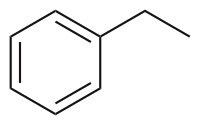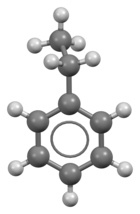
| |||
| |||
| Names | |||
|---|---|---|---|
| Preferred IUPAC name Ethylbenzene | |||
| Other names Ethylbenzol; Phenylethane; alpha-Methyltoluene; EB | |||
| Identifiers | |||
| CAS Number | |||
| 3D model (JSmol) | |||
| Abbreviations | EB | ||
| Beilstein Reference | 1901871 | ||
| ChEBI | |||
| ChEMBL | |||
| ChemSpider | |||
| DrugBank | |||
| ECHA InfoCard | 100.002.591 | ||
| KEGG | |||
| PubChem CID | |||
| RTECS number |
| ||
| UNII | |||
| CompTox Dashboard (EPA) | |||
InChI
| |||
SMILES
| |||
| Properties | |||
| Chemical formula | C8H10 | ||
| Molar mass | 106.168 g·mol | ||
| Appearance | colorless liquid | ||
| Odor | aromatic | ||
| Density | 0.8665 g/mL | ||
| Melting point | −95 °C (−139 °F; 178 K) | ||
| Boiling point | 136 °C (277 °F; 409 K) | ||
| Solubility in water | 0.015 g/100 mL (20 °C) | ||
| log P | 3.27 | ||
| Vapor pressure | 9.998 mmHg | ||
| Magnetic susceptibility (χ) | -77.20·10 cm/mol | ||
| Refractive index (nD) | 1.495 | ||
| Viscosity | 0.669 cP at 20 °C | ||
| Dipole moment | 0.58 D | ||
| Thermochemistry | |||
| Heat capacity (C) | 1.726 J/(gK) | ||
| Hazards | |||
| Occupational safety and health (OHS/OSH): | |||
| Main hazards | Flammable | ||
| GHS labelling: | |||
| Pictograms |    
| ||
| Signal word | Danger | ||
| Hazard statements | H225, H304, H320, H332, H335, H336, H351, H360, H373, H400, H411 | ||
| Precautionary statements | P201, P202, P210, P233, P240, P241, P242, P243, P260, P261, P264, P271, P273, P280, P281, P301+P310, P303+P361+P353, P304+P312, P304+P340, P305+P351+P338, P308+P313, P312, P314, P331, P337+P313, P370+P378, P391, P403+P233, P403+P235, P405, P501 | ||
| NFPA 704 (fire diamond) |
 | ||
| Flash point | 22.22 °C (72.00 °F; 295.37 K) | ||
| Autoignition temperature |
430 °C (806 °F; 703 K) | ||
| Explosive limits | 1–7.8% | ||
| Lethal dose or concentration (LD, LC): | |||
| LD50 (median dose) | 5460 mg/kg | ||
| LCLo (lowest published) | 4000 ppm (rat, 4 hr) | ||
| NIOSH (US health exposure limits): | |||
| PEL (Permissible) | TWA 100 ppm (435 mg/m) | ||
| REL (Recommended) | TWA 100 ppm (435 mg/m) ST 125 ppm (545 mg/m) | ||
| IDLH (Immediate danger) | 800 ppm | ||
| Related compounds | |||
| Related aromatic hydrocarbons |
styrene, toluene | ||
| Related compounds | benzene ethylcyclohexane | ||
| Except where otherwise noted, data are given for materials in their standard state (at 25 °C , 100 kPa).
| |||
Ethylbenzene is an organic compound with the formula C6H5CH2CH3. It is a highly flammable, colorless liquid with an odor similar to that of gasoline. This monocyclic aromatic hydrocarbon is important in the petrochemical industry as a reaction intermediate in the production of styrene, the precursor to polystyrene, a common plastic material. In 2012, more than 99% of ethylbenzene produced was consumed in the production of styrene.
Occurrence and applications
Ethylbenzene occurs naturally in coal tar and petroleum.
The dominant application of ethylbenzene is its role as an intermediate in the production of polystyrene. Catalytic dehydrogenation of ethylbenzene gives hydrogen and styrene:
- C
6H
5CH
2CH
3 → C6H5CH=CH2 + H
2
As of May 2012, more than 99% of all the ethylbenzene produced is used for this purpose.
Ethylbenzene hydroperoxide, a reagent and radical initiator, is produced by autoxidation of ethylbenzene:
- C6H5CH2CH3 + O2 → C6H5CH(O2H)CH3
Niche uses
Ethylbenzene is added to gasoline as an anti-knock agent to reduce engine knocking and increase the octane rating. Ethylbenzene is often found in other products, including pesticides, cellulose acetate, synthetic rubber, paints, and inks. Used in the recovery of natural gas, ethylbenzene may be injected into the ground.
Production
Ethylbenzene is produced on a large scale by combining benzene and ethene in an acid-catalyzed chemical reaction:
- C
6H
6 + C
2H
4 → C
6H
5CH
2CH
3
In 2012, more than 99% of ethylbenzene was produced in this way.
Small amounts of ethylbenzene are recovered from the mix of xylenes by superfractioning, an extension of the distillation process.
In the 1980s a zeolite-based process using vapor phase alkylation offered a higher purity and yield. Then a liquid phase process was introduced using zeolite catalysts. This offers low benzene-to-ethylene ratios, reducing the size of the required equipment and lowering byproduct production.
Industrial accidents
On June 3, 2014, an explosion occurred in the Dutch Moerdijk industrial area. This happened in a chemical reactor operated by Shell which overheated due to an exothermal runaway reaction between the metal oxide catalyst and ethylbenzene.
Health effects
The acute toxicity of ethylbenzene is low, with an LD50 of about 4 grams per kilogram of body weight. The longer term toxicity and carcinogenicity is ambiguous. Eye and throat sensitivity can occur when high level exposure to ethylbenzene in the air occurs. At higher level exposure, ethylbenzene can cause dizziness. Once inside the body, ethylbenzene biodegrades to 1-phenylethanol, acetophenone, phenylglyoxylic acid, mandelic acid, benzoic acid and hippuric acid. Ethylbenzene exposure can be determined by testing for the breakdown products in urine.
As of September 2007, the United States Environmental Protection Agency (EPA) determined that drinking water with a concentration of 30 parts per million (ppm) for one day or 3 ppm for ten days is not expected to have any adverse effect in children. Lifetime exposure of 0.7 ppm ethylbenzene is not expected to have any adverse effect either. The U.S. Occupational Safety and Health Administration (OSHA) limits exposure to workers to an average 100 ppm for an 8-hour workday, a 40-hour workweek.
Ethylbenzene is classified as a possible carcinogen by the International Agency for Research on Cancer (IARC) however, the EPA has not determined ethylbenzene to be a carcinogen. The National Toxicology Program conducted an inhalation study in rats and mice. Exposure to ethylbenzene resulted in an increased incidence of kidney and testicular tumors in male rats, and trends of increased kidney tumors in female rats, lung tumors in male mice, and liver tumors in female mice.
As with all organic compounds, ethylbenzene vapors form an explosive mixture with air. When transporting ethylbenzene, it is classified as a flammable liquid in class 3, Packing Group II.
Environmental effects
Ethylbenzene is found mostly as a vapor in the air since it can easily move from water and soil. A median concentration of 0.62 parts per billion (ppb) was found in urban air in 1999. A study conducted in 2012 found that in country air the median concentration was found to be 0.01 ppb and indoors the median concentration was 1.0 ppb. It can also be released into the air through the burning of coal, gas, and oil. The use of ethylbenzene in the industry contributes to ethylbenzene vapor in the air. After about three days in the air with the help of sunlight, other chemicals break down ethylbenzene into chemicals that can be found in smog. Since it does not readily bind to soil it can also easily move into groundwater. In surface water, it breaks down when it reacts with chemicals naturally found in water. Generally, ethylbenzene is not found in drinking water, however it can be found in residential drinking water wells if the wells are near waste sites, underground fuel storage tanks that are leaking, or landfills.
As of 2012, according to the EU Dangerous Substances Directive, ethylbenzene is not classified as hazardous to the environment.
Ethylbenzene is a constituent of tobacco smoke.
Biodegradation
Certain strains of the fungus Cladophialophora can grow on ethylbenzene. The bacterium Aromatoleum aromaticum EbN1 was discovered due to its ability to grow on ethylbenzene.
References
- ^ NIOSH Pocket Guide to Chemical Hazards. "#0264". National Institute for Occupational Safety and Health (NIOSH).
- Lange's Handbook of Chemistry (15th ed.). 1999.
- "Ethyl benzene". Immediately Dangerous to Life or Health Concentrations (IDLH). National Institute for Occupational Safety and Health (NIOSH).
- ^ "Ethylbenzene ToxFAQs" (PDF). Agency for Toxic Substances and Disease Registry. Retrieved 21 May 2018.
- ^ "ETHYLBENZENE : ENVIRONMENTAL, HEALTH & SAFETY GUIDELINES". CEFIC. Archived from the original on 19 September 2014. Retrieved 14 February 2013.
- "Ethylbenzene (EB) Production and Manufacturing Process". PIERS. Retrieved 14 February 2013.
- Summary shell moerdijk onderzoeksraad.nl July 2018
- ^ Vincent A.Welch, Kevin J. Fallon, Heinz-Peter Gelbke “Ethylbenzene” Ullmann’s Encyclopedia of Industrial Chemistry, Wiley-VCH, Weinheim, 2005. doi:10.1002/14356007.a10_035.pub2
- "Technology Transfer Network Air Toxics Web Site: Ethylbenzene". US Environmental Protection Agency. Retrieved 13 February 2013.
- "Ethylbenzene". eco-usa.net. Archived from the original on 25 December 2012. Retrieved 12 February 2013.
- Talhout, Reinskje; Schulz, Thomas; Florek, Ewa; Van Benthem, Jan; Wester, Piet; Opperhuizen, Antoon (2011). "Hazardous Compounds in Tobacco Smoke". International Journal of Environmental Research and Public Health. 8 (12): 613–628. doi:10.3390/ijerph8020613. ISSN 1660-4601. PMC 3084482. PMID 21556207.
- Francesc X. PRENAFETA-BOLDU; Andrea KUHN; Dion M. A. M. LUYKX; Heidrun ANKE; Johan W. van GROENESTIJN; Jan A. M. de BONT (April 2001). "Isolation and characterisation of fungi growing on volatile aromatic hydrocarbons as their sole carbon and energy source". Mycological Research. 105 (4): 477–484. doi:10.1017/s0953756201003719.
- Rabus, R.; Widdel, F. (1995). "Anaerobic degradation of ethylbenzene and other aromatic hydrocarbons by new denitrifying bacteria". Archives of Microbiology. 163 (2): 96–103. doi:10.1007/s002030050177. PMID 7710331.
- National Toxicology Program. Toxicology and Carcinogenesis Studies of Ethylbenzene (CAS No. 100-41-4) in F344/N Rats and B6C3F1 Mice (Inhalation Studies). TR No. 466. U.S. Department of Health and Human Services, Public Health Service, National Institutes of Health, Bethesda, MD. 1999.
External links
- National Pollutant Inventory - Ethybenzene Fact Sheet
- NLM Hazardous Substances Databank – Ethylbenzene
- EPA Chemical database
- Intox Chemical database
- Agency for Toxic Substances and Disease Registry
- CDC - NIOSH Pocket Guide to Chemical Hazards
| Hydrocarbons | |||||||||||||||||||||||||||||||||||
|---|---|---|---|---|---|---|---|---|---|---|---|---|---|---|---|---|---|---|---|---|---|---|---|---|---|---|---|---|---|---|---|---|---|---|---|
| Saturated aliphatic hydrocarbons |
| ||||||||||||||||||||||||||||||||||
| Unsaturated aliphatic hydrocarbons |
| ||||||||||||||||||||||||||||||||||
| Aromatic hydrocarbons |
| ||||||||||||||||||||||||||||||||||
| Other | |||||||||||||||||||||||||||||||||||

